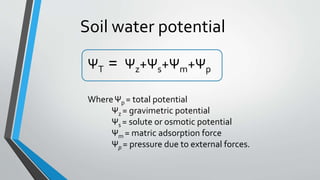Soil water potential
- 1. ΨT = Ψz+Ψs+Ψm+Ψp WhereΨp = total potential Ψz = gravimetric potential Ψs = solute or osmotic potential Ψm = matric adsorption force Ψp = pressure due to external forces. Soil water potential
- 2. • Higher moisture above the level of water table in soil, gravity exerts a positive pulling force water move downward. • When higher in moisture content below soil profile and drier above profile, this would be a negative value, the water is going to be pulled up into a drier soil layer above. z Gravimetric potential
- 3. Osmotic potential • Measurement of ions (dissolved salt) which exert positive attraction for water • Negative value • Indirect measurement of attraction that ions have in soil water potential equation. • As soil salt content increases, more free ions available, larger negative number s
- 4. Matric potential • Taking energy away from soil water • Force restricting the movement of water through the pore spaces • In any soil less than saturation, the soil will be negative number • Potential energy of water is influenced by the matrix potential and will be negative energy. • Dry soil- larger negative number m
- 5. Pressure potential •The pressure potential will be positive in a saturated soil •In unsaturated soils, the pressure potential is, usually, considered zerop
- 6. ΨT = Ψz+Ψs+Ψm+Ψp • The total soil water potential equation will give us a value when we add up all of the effects of the gravitation, matrix and osmotic • It will give us a value which will be a negative number at anything less than saturation. • Water will move in soil profile from an area of high content to an area of lower content •ΨT Can be measured in kPa, bars or atmospheres
- 7. ΨT = Ψz+Ψs+Ψm+Ψp • Smaller negative number, the higher the water content in the soil pores • The larger the negative number, the lower content will be in the soil pores Water will moves from area of higher to lower concentration Water moves from area of a lower negative value forΨT towards to an area of a higher negative value forΨT. Or
- 8. Soil water potential log scale • The sandy soil holding considerably less water than the loam soil which holding correspondingly less amount of total water than the clay (fine textured soil) • In all case as soil water potential increases or becomes a larger negative number the soil will end up losing water regardless of whether it’s medium or fine texture soil • The best thing to use this graphic to illustrate is what type of soil moisture is remaining at a given soil water potential value.
- 9. At -0.1 bars/atmospheres to -1 bars/atmospheres: • The sandy soil is not holding very much water • The loam soil is holding an intermediate amount • The finer clay texture soil is holding the most water at that soil water potential • -1 bars/atmospheres is not a large negative number, it is high value and has a lot of usable water in the soil profile
- 10. At -10 bars/atmospheres • The water deficiency point for plants is usually around -10 bars/atmospheres and it is vary from one plant to another • It is fairly representative value that most of crop plants at least can take water out of soil profile without significantly damaging their yield potential • Everything’s going to this value it’s a combination of gravitational, matric and osmotic potentials
- 11. Conclusion of suitable value of soil water potential for plants • For all the practical purposes, the level of water being held between -0.1 to -10 bars/atmospheres is really usable water that being stored in the soil plant. • At -10 to -100 bars/atmospheres is very little water left in the soil profile. Rarely plants are able survive and utilize water from soils down to this level.
